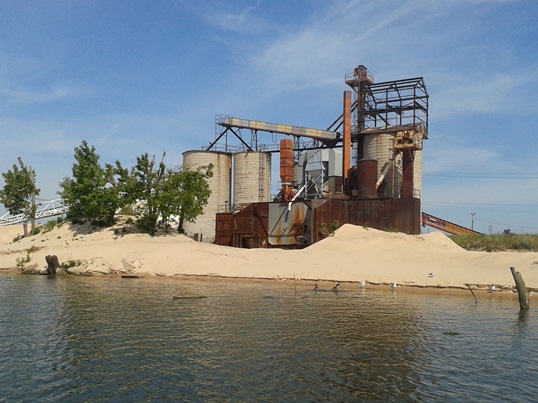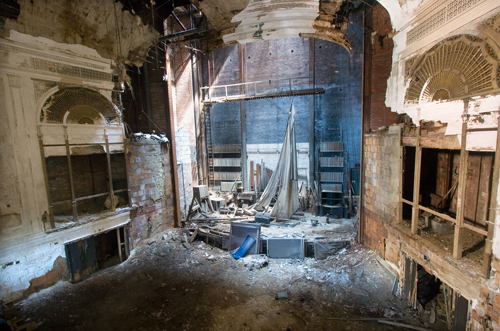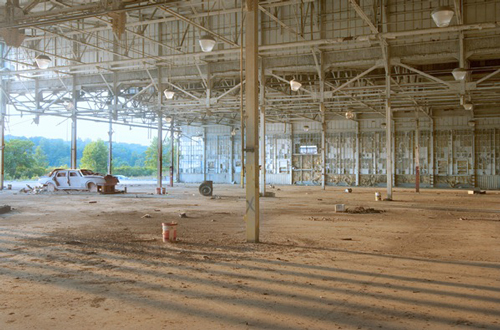I like ruin porn. To many I am nasty. I am aware of this. But please, hear me out.
First, let me back up a minute. If you aren't from the Rust Belt you need to know something: vacancy lives here. In fact, its ubiquity has granted it a presence in our post-industrial culture.
Take art, for instance. Abandonment has seeped into painters' canvases and into the inkwells of writers, yet the crux of abandonment's aesthetic value has mainly been argued within the field photography, particularly the practice of photographing industrial and urban ruins. This has been dubbed "ruin porn." And it has been an uphill battle for the genre's supporters ever since.

Enter the power of language. Because even before you get to analyze the practice of ruin photography on its own merit, you get the connotations of porn filmed over your judgment. And so the act of filming ruins becomes the act of filming filth, meaning the resultant audience is less interested in artistic quality than they are titillation. After all, it's pornographic. It says so right in the name.
Framing, it's an old trick, used by preschoolers and politicians alike, as the name "tattle-tale" sticks no less than "flip-flopper." Framing can destroy in that sense, even in art. Just look at that period in the country's history when being called a "communist" meant your films were socially perverse.
But in the end, framing on its own won't hold up. And so evolve reasons to give the "porn" label some weight, if only to convince folks that ruin art is light, cheap, voyeuristic: a still shot of Hoarders mixed with Intervention, or, for that matter, all things reveling in America's happiness with another's pain.
One critique is journalistic laziness -- out-of-towner flies into Detroit and captures yet another over-dramatic shot of Detroit's Michigan Central Depot before bolting. There's validity to this argument, but in and of itself it doesn't disqualify the potential of the medium. After all, isn't that on the schmuckiness of the artist instead of on the quality of the genre?
Another critique centers on the fact there are no people in ruin porn shots. For such critics, it's tasteless to document the ruins of cities without showcasing the people who live beside the decay. One critic writes:
The one thing they (ruin photos) have in common no matter who has taken them is that there are never any people in them. And to me, that points to the problem. There are no people interacting with the ruins.
Well, in Cleveland I have yet to see many folks "interacting with ruins" outside of copper thieves and the general sleepy/drunk squatter, and believe me: they don't want their pic snapped. But beyond that: ruin porn is a thread of landscape photography, and I don't remember Ansel Adams getting criticized because his epic landscape shots didn't have backpackers milling about. Of course, critics will contend that traditional landscape shots aren't intertwined with a city's (and thus, a people's) demise, which brings us to the next most common critique: ruin porn sensationalizes the poor.
For example, in this post the author critiques German photographer Christian Burkert's series of photos titled "Last Exit Detroit" this way:
What's problematic about this approach (ruin porn) is that it does little but gawk at the cities and people in distress. In other words, it actually contributes to the problem by fueling the notion that Detroit (and depressed cities like it) are beyond help.
Two things here: First, I feel documenting abandonment can in fact out the conditions of poverty, showing -- like Jacob Riis' seminal work did back in 1890 -- not so much how the other half lives, but what the other half lives with. Lord knows this is necessary. Plight and blight are to the eyes like one's hand is to fire: instinctually distanced. (See Mitt Romney's famous quote about not being concerned about the "very poor."). Then pause to reflect how what has happened to us is needed here. Show it. Debate it. Shutting it down under the auspices of porn actually makes the living images dirtier than they are.
Second -- and this speaks to the ruin porn critique in general -- there's something of an amorphous/ambiguousness nature to the attacks that tells the creator and supporter of the medium that: you can't win for losing. For example, here is one of the photos from Burkert's series, here's another and there are many more like it.

Photo credit: Sean Posey
Yeah, I don't get it either. Far from "gawking" or "fueling" the notion that Detroit is beyond help, you know what I see? The aesthetic of a world I live in every day. Rust. Wear. And folks trying to fix what's broken.
And about that indefinable nature of the attack, well, it often works. Note the frustration and confusion in Matthew Christopher's great post Confessions of a Ruin Pornographer: A Lurid Tale of Art, Double Standards, and Decay:
The nebulous nature of the term and its use as an insult means that it can be employed without much consequence and is frustratingly difficult to rebut.... Because the core definition is ill-defined and constantly shifting, there is no way to adequately defend yourself: whatever it is that you're doing, you should be doing something else, but in the meanwhile your work bears the sleazy stigma of comparison to that of such esteemed photographers as those found in Hustler or Penthouse and you, by extension, are less an artist than a pornographer.
And finally, there's the latest, almost subtle attack -- or that's it time to move beyond "ruin porn" and talk about what's next. To some extent I agree, yet the truth's more complicated, as the term "ruin porn" has disallowed a true discourse on the understanding of modern America in ruins no less than the term "family values" has hindered the discourse on the state of the modern American family.
So: Shut it down. Do something else. Stop making the gawking. Stop documenting decay. Ruin ain't pretty.

Photo credit: Sean Posey
Behind the "porn" grenades, these are the core messages that can be teased out. And I am coming to the conclusion that they are fed not so much by the more surface message that ruin porn is bad per se, but rather by something deeper -- or an incapability in the American psyche to incorporate failure into the American dream.
To that end, I recently came across this 1972 gem of a paragraph that touches on this incapability perfectly. It's from a book prophetically entitled Urban Wilderness by urban historian Sam Bass Warner Jr.
American Urban Life confuses us in its intermingling of endless repetition with ceaseless change. Consider our habitual responses. We do not see in the brand-new downtown apartment towers or the freshly carpeted suburban model home the inevitable repetition of failure which surely awaits them...The newness is a goal for family achievement, the reality of aging is either to be obliterated or escaped [italics mine]. The past is not seen in the present... These are deep habits of mind.
Warner Jr. goes on:
Since at least the founding of the Republic we have been concealing failure from ourselves with newness.... Thus for generations we have dwelt in a self-created urban wilderness of time and space, confounding ourselves with its lusty growth and rising to periodic alarms in the night. It is no accident that we have no urban history.
But of course we do have history. And it's messy -- tinged with both beauty and filth. And it will exist regardless if its documentation is shamed to a halt.
Now, if you would excuse me, I am going to take my laptop and look at some ruin porn. Alas, I will be far less titillated than thoughtfully wondering.
A version of this post originally appeared in Rust Wire.
